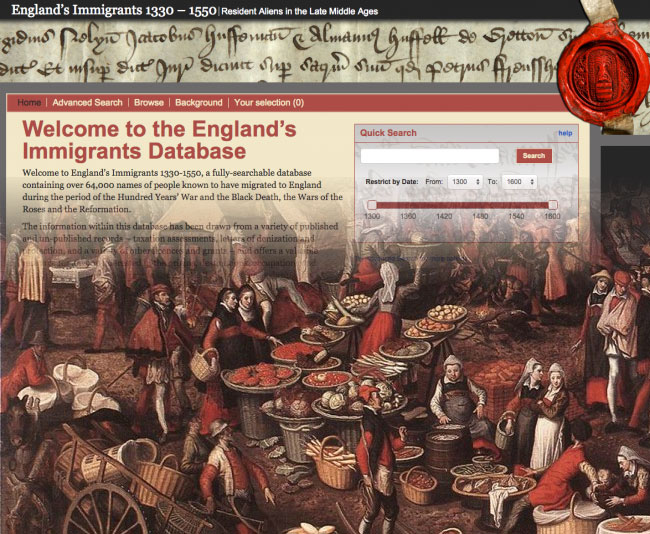The Arts and Humanities Research Council (AHRC) funded the three-year project directed by Professor Mark Ormrod, of the University of York’s Centre for Medieval Studies, who headed a team of researchers based in York and London.
National Identity
It reveals evidence about the names, origins, occupations and households of a significant number of foreign nationals who chose to live and work in England in the era of the Hundred Years War, the Black Death and the Wars of the Roses. The project contributes to debates about the longer-term history of immigration to Britain, helping to provide a deep historical and cultural context to contemporary debates over ethnicity, multiculturalism and national identity.
This project has focussed on four key sets of questions, which together constitute its principal research strands:
People. Who were England’s immigrants in the period 1330-1550? Where did they come from? Where did they live and work? How did they relate to other incomers and the native population? How long did they stay? How did they relate to the structures and institutions of English society?
Rules. How did central government, and its local representatives in town and country, define and regulate immigrants and immigration? How did ideology, international politics, the state of the economy and public opinion influence policy-making?
Work. What were the roles of immigrants in the agricultural, manufacturing and commercial economies of late-medieval England? How was their economic contribution viewed? What connections can be established between availability of work and immigration?
Culture. To what extent were immigrants integrated into the host society? What formal or informal types of ‘ghetto-isation’ were applied to them? How did English interactions with ‘strangers’ inform ideas of ethnicity and nationality?
Database of names
The database contains the names of a total of 65,000 immigrants resident in England between 1330 and 1550.
In one year, 1440, the names of 14,500 individuals were recorded – this at a time when the population of England was approximately two million.
Taking into account gaps in the records, the researchers estimated that one person in every hundred was a foreign national. They were found in all counties, from Cornwall to Northumberland, in hamlets as well as in major ports. Their nationalities ranged from people from other parts of the British Isles, including Scots, Irish and Channel Islanders, to mainland Europeans from Portugal to Sweden, from Greece to Iceland.

In many cases the occupation of the individual is known, from highly skilled craftsmen such as goldsmiths, to weavers – many of whom were Flemish – to agricultural labourers. Three Flemish weavers from Diest in Belgium lived and worked in St Ives, Huntingdonshire, in the 1330s; and John Lammyns, a goldsmith from Antwerp, lived in Bristol in the 1430s and 1440s. The research reveals that aristocratic households brought back foreign servants from English-occupied France at the end of the Hundred Years War: Sir John Montgomery of Faulkbourne, Essex, had five foreigners working in his household in the 1440s. Many ordinary families of traders, artisans and workers chose to migrate to England. Walter, a minstrel from Germany, settled in London in the late fifteenth century with his entire family, including his mother, wife, three sons and three daughters.
One of the surprises revealed by the research is the number of resident immigrants who lived and worked in rural areas, rather than in towns and cities. The research reveals how such people integrated – and sometimes clashed – with English people, suggesting much about how our ancestors used language, dress and behaviour as symbols of national identity.
Professor Ormrod says: “The England’s Immigrants project transforms our understanding of the way that English people and foreign nationals, of all levels of society, lived and worked together in the era of the Plantagenets and early Tudors. The research provides a deep historical context for modern debates about the movement of peoples and the state’s responsibilities to regulate immigration.”
The database is accessible to all at www.englandsimmigrants.com and is a fully searchable and interactive resource, from which data can be downloaded. The website also supports the researcher with guides to the various counties and documents, and provides case studies of interesting individuals demonstrating just how much we can learn from our immigrant ancestors.
Further information:
- For more information on the England’s Immigrants project, please visit www.englandsimmigrants.com
- More on the Centre for Medieval Studies at the University of York at www.york.ac.uk/medieval-studies/

